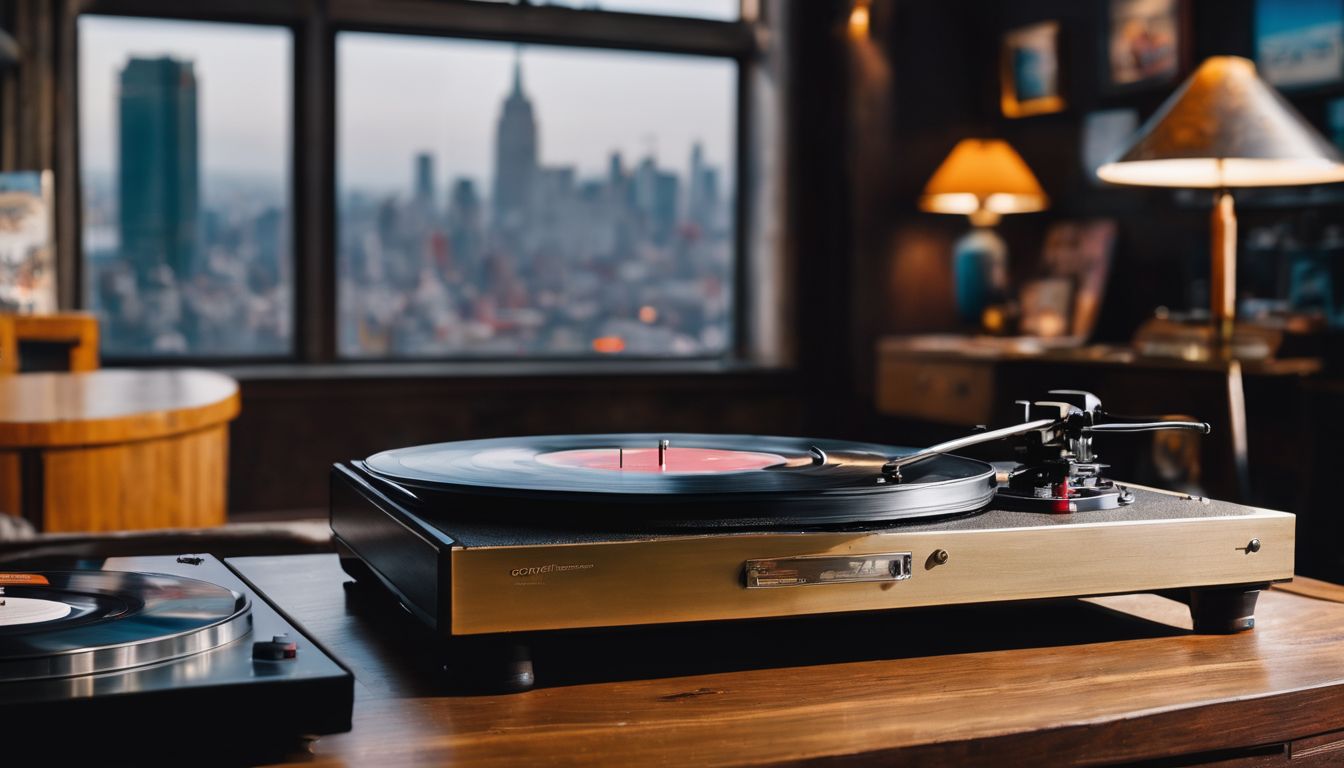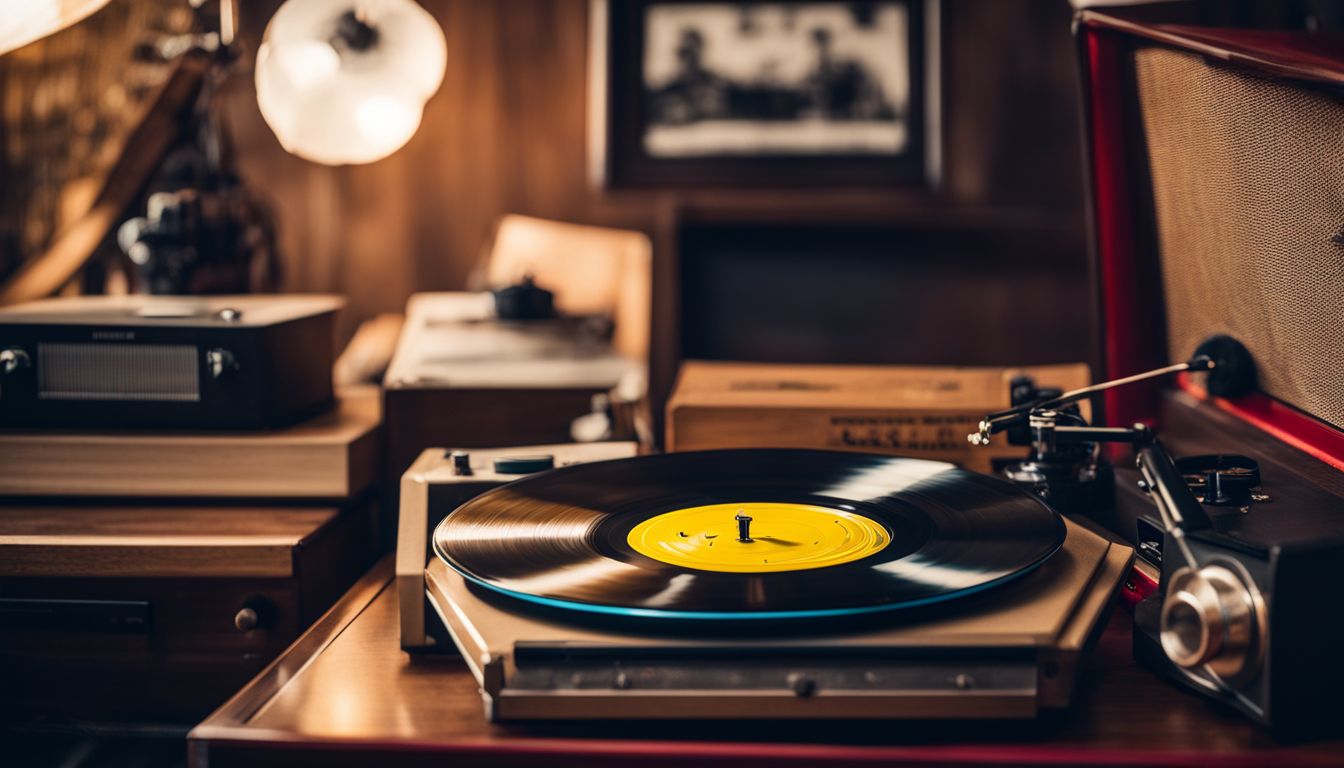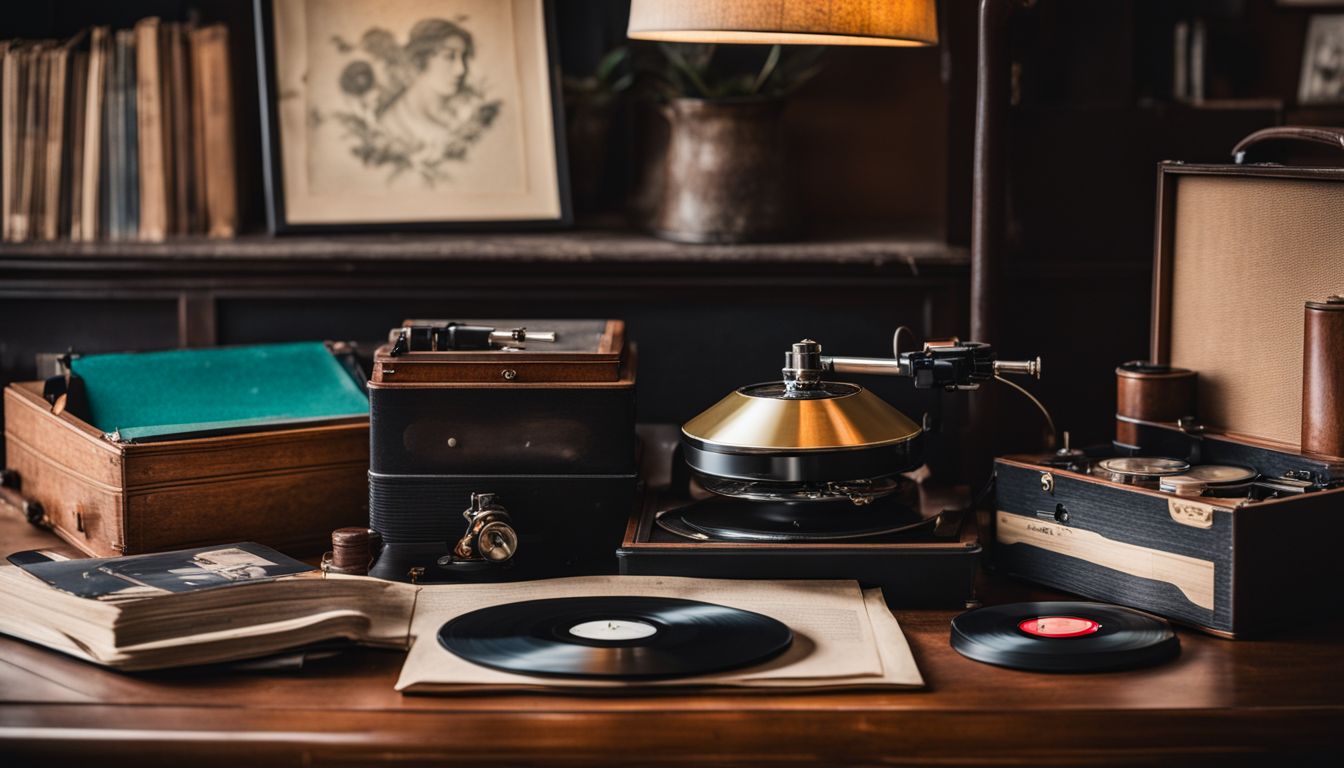If you’ve ever wondered why your favorite vinyl sounds just right, it’s all about the RPM. RPM stands for Revolutions Per Minute, a key factor that makes music come alive on record players.
This article will unlock the mystery of vinyl record speeds and sizes, ensuring you get the best sound from your collection. Dive in to spin your tunes perfectly!
Key Takeaways
- RPM means “revolutions per minute” and signifies how fast a record spins on the turntable, affecting the playback speed and pitch of music.
- Records come in different sizes that correspond to specific speeds: 7-inch records usually play at 45 RPM, while 12-inch LPs (long plays) typically spin at 33 RPM; older 10-inch records might run at either 78 or 33 RPM.
- The introduction of the long-playing (LP) vinyl record by Columbia Records in 1948 enabled albums with longer playtimes than the earlier shellac discs that played at 78 RPM.
- A well-maintained needle is crucial for capturing the nuances of music on vinyl accurately and ensuring playback happens at the correct speed without distortions like wow and flutter.
- Regular maintenance of your record player, including checking belts, cleaning needles, oiling moving parts, monitoring turntable speed accuracy, aligning tonearms correctly, and storing vinyl properly, will enhance sound quality and extend both equipment and record longevity.
Understanding the RPM (Revolutions Per Minute) on a Record Player
RPM stands for revolutions per minute, indicating how many times a vinyl record spins completely on the player within sixty seconds. It directly affects the auditory experience of the listener by ensuring that the music is played at its intended speed and pitch.
The Meaning of 33, 45, and 78 RPM
RPM stands for “revolutions per minute,” and it tells you how fast a vinyl record spins on the turntable. Each number represents a different speed setting, which is essential for playing the record correctly.
Records that spin at 33 RPM are generally longer albums with multiple tracks, allowing more music to fit on each side of the disc. This slower speed became popular after World War II, offering listeners extended play times and improved sound quality compared to its predecessors.
Artists and producers often use 45 RPM for singles or shorter recordings. These records are smaller in diameter but revolve faster than the 33s, which results in high sound fidelity, ideal for hit songs or EPs (extended plays).
The oldest of these formats is the 78 RPM, made from shellac before World War II ended its reign as the main format due to its limited playing time and fragile nature. Notably, modern turntables may require special needles or adjustments to accommodate the rarer 78 RPM records that once set industry standards but now offer a nostalgic glimpse into early music technology.
The history of vinyl record speeds
Delving into the history of vinyl record speeds reveals a fascinating evolution from early phonographs to modern turntables, with each technological leap reshaping the music industry and how we experience audio entertainment. Continue reading to uncover these pivotal moments.
Early Phonographs and the Creation of 78 RPM
Early phonographs spun a whole new tune into the world of audio recording. In 1888, Emile Berliner revolutionized music playback with his invention of the disc record, which typically rotated at speeds between 70 and 80 RPM.
These flat discs were a stark contrast to Thomas Edison’s earlier cylindrical phonograph recordings and set a fresh standard for sound reproduction.
The adoption of 78 RPM for turntables became widespread by 1925, marking it as the official speed for vinyl records. Despite their popularity, these shellac discs held limitations in duration and durability; they could play only a few minutes per side and were prone to shattering if dropped.
After setting the stage for home entertainment, this format eventually bowed out after World War II due to these shortcomings. Now let’s explore how newer speeds, like 33 RPM, brought longer play times and changed our listening habits forever.
The invention of 33 RPM and the release of 45 RPM
Columbia Records made history in 1948 by introducing the 33 RPM vinyl disc, changing how we listen to music forever. This format allowed for longer playing times, revolutionized audio recording methods and enabled albums with multiple tracks.
No longer were listeners confined to short bursts of songs; they could now enjoy an entire symphony without interruption. The invention marked a significant leap from Emile Berliner’s original disc records that spun between 70 and 80 RPM.
Soon after Columbia’s innovation, RCA entered the format wars with the release of the 45 RPM record in hopes of dominating the market. Designed to be smaller and more convenient than its predecessor, the new size is aimed at a niche audience looking for single hits rather than full-length albums.
Both formats offered high-fidelity sound quality compared to earlier cylinders, but neither would provide a decisive advantage over the longstanding 78s until later technological advancements took place.
Up next: understanding how these varying speeds correlate with different vinyl record sizes.
Understanding the Vinyl Record Size Chart
Delve into the world of vinyl with a clear understanding of how record sizes directly influence playback speed, ensuring you match the right RPM to your cherished collection for optimal listening pleasure.
Record Sizes and Their Corresponding Speeds
Understanding the relationship between vinyl record sizes and their corresponding speeds is pivotal for both seasoned collectors and newcomers to the world of vinyl. Vinyl record size directly determines its rotational speed, measured in revolutions per minute (RPM), which is crucial for accurate playback of the recorded music.
| Record Diameter (Inches) | Common Speed (RPM) | Typical Use |
| 7″ | 45 | Singles and EPs |
| 10″ | 78 | Early classical and jazz recordings (pre-WWII) |
| 10″ | 33 | LPs (less common), classical recordings |
| 12″ | 33 | LPs (Long Play), albums |
| 12″ | 45 | Audiophile pressings, singles with extended playtime |
The 7-inch records at 45 RPM became popular for their enhanced sound quality over the older 78 RPM, despite not initially providing much advantage. Conversely, 12-inch long-playing (LP) records at 33 RPM revolutionized the music industry with the capacity to hold approximately 22 minutes of music per side, emerging in 1948. Not all turntables are capable of playing the once-standard 78 RPM records, and those that are often require special needles to accurately capture their unique grooves.
Next, let’s explore the role of the needle in ensuring the record player’s speed and accuracy.
The Role of the Needle in Record Player Speed and Accuracy
The needle, or stylus, plays a critical role in how a vinyl record player reads the grooves and produces sound. Its precision determines both the quality of audio output and the speed at which it interprets the record’s information.
With accuracy, a well-calibrated needle captures every nuance of music at the correct RPM as it drops into the groove.
Keeping your record player’s needle in top condition is essential for playing records at their intended speeds. Switching between different formats, like LPs and singles, on versatile systems such as the Electrohome Kingston 7-in-1 Vinyl Record Player can be greatly improved by using a specialized stylus designed for 78 RPM records.
Accurate tracking by the needle prevents speed variations, also known as wow and flutter, guaranteeing that what you hear stays true to the original recording.
Maintaining Speed and Maintenance of the Record Player
Keeping your record player at the proper speed ensures optimal sound quality and prolongs the life of your vinyl records. Regular maintenance is essential to prevent wear and tear on both the turntable and your music collection.
- Check the belt regularly if you have a belt-drive turntable. Over time, belts can stretch or break, leading to inconsistent speeds. Replace them as needed for continued smooth operation.
- Dust off the platter and the needle before each use. Accumulated dust can cause friction and drag, affecting playback speed and potentially damaging records.
- Oil the motor and other moving parts annually. Just like any machinery, a record player benefits from lubrication to keep parts moving without resistance.
- Use a stroboscopic disc or an app designed for this purpose to monitor turntable speed. These tools ensure accurate achievement of 33 ⅓ RPM and 45 RPM for precise playback.
- Align the tonearm correctly; an improperly set tonearm can lead to skipping or dragging that alters playback speed. Follow the manufacturer’s guidelines to adjust it perfectly.
- Store vinyl records properly in a vertical position to avoid warping. Warped records can cause variations in playback speed when the needle travels over uneven surfaces.
Conclusion
Exploring the world of vinyl record speeds and sizes reveals a fascinating blend of history, technology, and artistry. Each RPM has its own story, with 33s bringing albums to life, 45s setting singles spinning, and rare 78s holding echoes from the past.
The mechanics behind playing your favorite tunes on a turntable are intricately connected to these revolutions per minute. Dive into this classic audio experience; let each spin take you back in time or deepen your appreciation for high-quality sound.
Record players carry more than just music—they bring tradition and innovation together in every rotation.
FAQs
What does RPM mean on a vinyl record player?
The record spins on the turntable at a certain speed, measured in RPM (revolutions per minute), which affects the pitch and tempo of the music played on vinyl records.
Why are there different RPM speeds for records?
Different RPM speeds, like 33 1/3, 45, and 78, were developed to suit various sizes of vinyl records and recording lengths, with each speed being optimal for a certain type of listening experience.
Can all record players play at any speed?
Many modern record players come equipped with settings to adjust between common speeds such as 33 1/3 and 45 RPM; however, playing vintage 78 RPM records may require a specialized player or an adapter.
How do I know which speed setting to use for my vinyl?
Check the label in the center of your vinyl; it tells you whether it’s designed to spin at either 33 1/3, 45,45 or possibly even at rare times at a rate of approximately the average rate compared.


